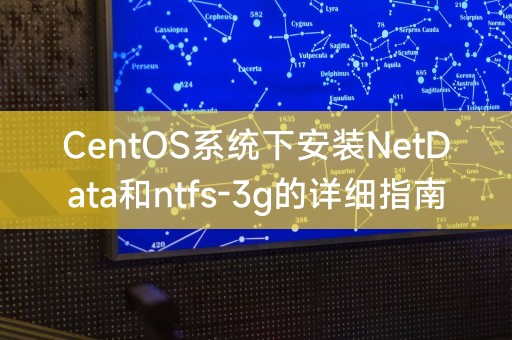
Under CentOS system, installing NetData and ntfs-3g is an important task. NetData is a powerful system monitoring tool that can monitor server performance and resource usage in real time. And ntfs-3g is a driver for reading and writing NTFS file systems in Linux systems, which can easily interact with Windows systems. This article will provide you with a detailed installation guide to help you easily install and configure these two tools. Let’s take a look!

1. Download NetData
We need to download the version suitable for CentOS system from the official website of NetData. After the download is completed , decompress the compressed package to the appropriate location.
2. Configure NetData
After decompression is completed, enter the NetData installation directory and execute the following command to configure:
```bash
./ configure --with-python3-enabled
```
This command will check the system environment and generate the configuration file.
3. Compile and install NetData
Execute the following commands to compile and install:
make
sudo make install
Installation completed Afterwards, NetData will start automatically.
1. Download ntfs-3g
We need to download the version suitable for CentOS system from the official website of ntfs-3g. After the download is completed, it will be compressed Unzip the package to the appropriate location.
2. Install dependency packages
Before installing ntfs-3g, you need to install some dependency packages. Execute the following command to install:
sudo yum install -y fuse libfuse libntfs-3g libntfs-3g-devel
3. Compile and install ntfs-3g
Enter the installation directory of ntfs-3g and execute the following commands to compile and install:
./configure --with-fuse=internal --disable-example-tests --disable-fusermount --disable-ntfsprogs --disable-ntfscat --disable-ntfsls --disable-ntfsmount --disable-ntfspart --disable -ntfspartx --disable-ntfstruncate --disable-ntfsck --disable-ntfsmount --disable-ntfscmp --disable-ntfspersist --disable-ntfspersistx --disable-ntfsclone --disable-ntfscluster --disable-ntfsclusterx --disable -ntfscc --disable-ntfschange --disable-ntfscc2 --disable-ntfscheck --disable-ntfscheck2 --disable-ntfscp --disable-ntfscp2 --disable-ntfsresize --disable-ntfsresize2 --disable-ntfssetsize --disable -ntfssetsize2 --disable-ntfsresize_real --disable-ntfssetsize_real --disable-ntfstrim --disable-ntfstruncate --disable-ntfstruncate2 --disable-ntfsync --disable-ntfsunmount --disable-ntfsunmount2 --disable-ntfspersist_all --disable -ntfspersistx_all --disable-ntfsclone_all --disable-ntfscluster_all --disable-ntfsclusterx_all --disable-ntfscc_all --disable-ntfscheck_all --disable-ntfscheck2_all --disable-ntfscp_all --disable-ntfscp2_all --disable-ntfsresize_all --disable -ntfssetsize_all --disable-ntfstruncate_all --disable-ntfsunmount_all --with-libfuse=internal
After the installation is completed, we can access the NTFS partition under the Windows system under the Linux system.
The above is the detailed content of Detailed guide to installing NetData and ntfs-3g under CentOS system. For more information, please follow other related articles on the PHP Chinese website!




